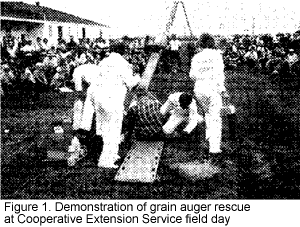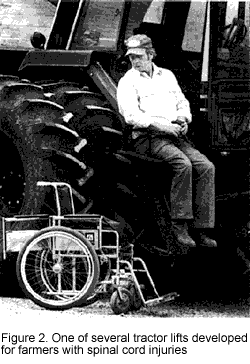Agriculture continues to be the most hazardous U.S. industry, despite decreases in overall work-related accidents. In 1989, an estimated 1,300 lives were lost, and 120,000 disabling injuries experienced on farms and ranches. Victims of farm-related injuries in the United States incur approximately $2.5 billion in hospital and rehabilitation costs each year.
The Cooperative Extension System (CES) has developed and put into practice educational programs that apply a holistic approach to agricultural safety and health. Programs range from PREVENTION of traumatic injury and health hazards, to RESCUE of farm accident victims, to REHABILITATION of farmers with disabling injuries. These programs complement and mutually support one another. For example, rescue programs stress prevention of further injuring victims and preventing rescuer injuries. Rehabilitation programs stress safe practices and workplace modifications for prevention of additional injuries.
PREVENTION
 CES supports farm safety education programs in all 50 states
and Puerto Rico. The programs teach farmers, ranchers, agricultural
workers, and farm families how to:
CES supports farm safety education programs in all 50 states
and Puerto Rico. The programs teach farmers, ranchers, agricultural
workers, and farm families how to:
State farm safety leaders develop programs to meet their states' most critical needs.
RESCUE
REHABILITATION
 More than 500,000 agricultural workers have physical disabilities
that limit their ability to do their jobs. Each year, more than
100,000 disabling injuries happen on farms, many of which are
far removed from urban-based sources of help. Rural locations
also generally lack specialized education or therapy facilities
needed to put the disabled to work in safe and productive agricultural
operations (see Figure 2).
More than 500,000 agricultural workers have physical disabilities
that limit their ability to do their jobs. Each year, more than
100,000 disabling injuries happen on farms, many of which are
far removed from urban-based sources of help. Rural locations
also generally lack specialized education or therapy facilities
needed to put the disabled to work in safe and productive agricultural
operations (see Figure 2).
CES has exceptional programs and expertise, such as the Breaking New Ground Resource Center in Indiana, and the Rural and Farm Family Vocational Rehabilitation Program in Vermont. To meet needs, CES rehabilitation programs often draw upon partnerships with other organizations such as the Iowa Easter Seal Society's Farm Family Rehabilitation Management (FaRM) Program.
Congress has provided new funds to establish and enhance educational and assistance programs for farmers with disabilities. To initiate this program, grants were awarded to Extension Service/Easter Seal partnerships in 10 states. State projects are underway in Illinois, Indiana, Iowa, Louisiana, New York, Vermont, and Wisconsin, and a regional program serving Montana, Idaho, and Wyoming.
To find out what programs and resources are available in your area, contact the Cooperative Extension County Agent (listed in your local telephone directory, usually under county government) or Extension Farm Safety Leader, who is at your state land-grant institution.
Publication #: 0-866-310
This document is a Farm Safety Fact Sheet, United States Department of Agriculture Extension Service. Publication date: May 1991.
Bradley K. Rein, National Program Leader, Agri-Industry Systems/Farm Safety, United States Department of Agriculture, Washington, DC, 20250-2260.
Mention or display of a trademark, proprietary product, or firm in text or figures does not constitute an endorsement by the U.S. Department of Agriculture and does not imply approval to the exclusion of other products or firms.
Disclaimer and Reproduction Information: Information in NASD does not represent NIOSH policy. Information included in NASD appears by permission of the author and/or copyright holder. More